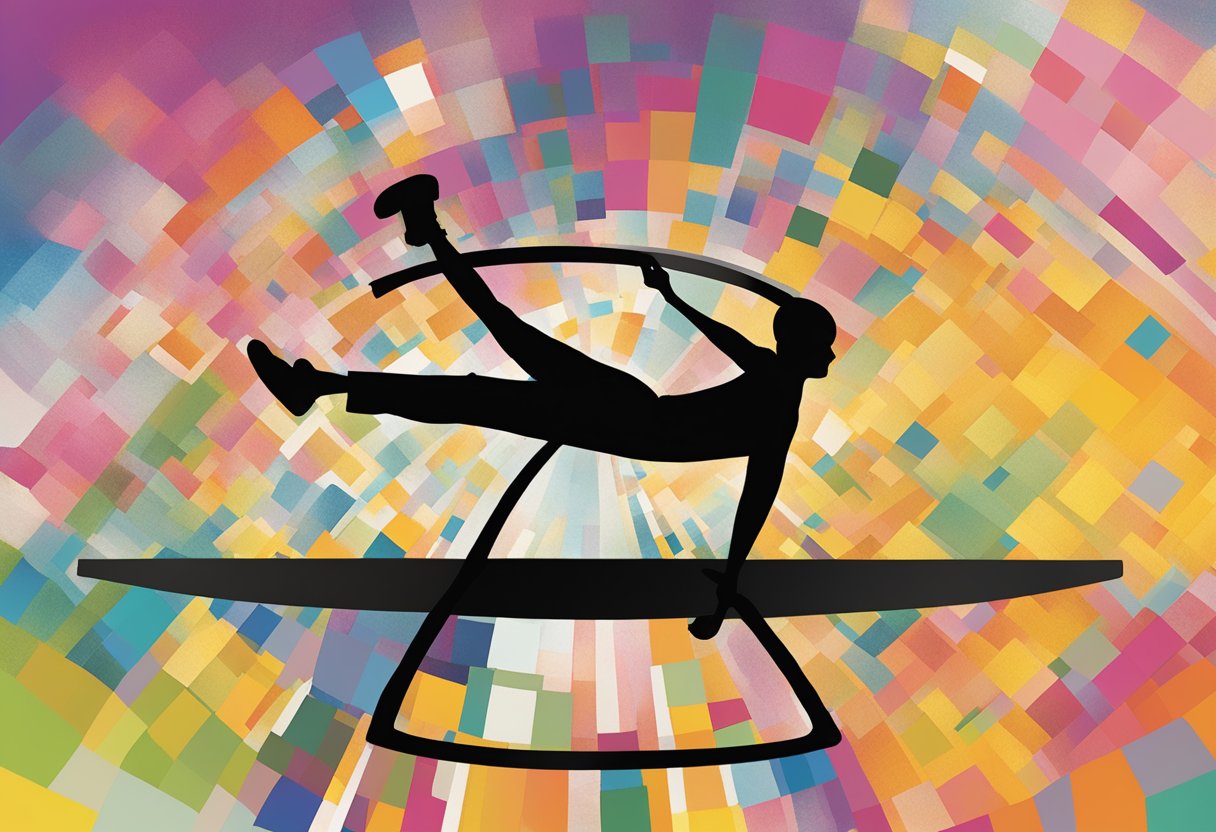Enhancing Stability and Well-being
Navigating the journey after cancer treatment brings its unique set of challenges. As survivors, we strive to regain our health and vitality. Often, we seek ways to enhance our physical fitness.
Balance exercises offer a path to recovering not only our strength but also our confidence in our bodies. These exercises are tailored to meet the specific needs that arise for survivors, including the management of neuropathy—a common side effect of treatments like chemotherapy. Focusing on routines that improve our stability, we regain control over our movements and daily activities.

Starting an exercise program and post-cancer treatment can be daunting, especially for men who might face the worry of re-establishing physical conditions. We understand the need for a supportive environment that eases the transition into regular exercise.
Consulting healthcare authorities for exercise guidelines ensures the safety and effectiveness of our fitness plans. From standing on one foot to performing lateral movements, the variety of balance exercises we incorporate can combat the physical challenges experienced after cancer treatments, enabling a smoother recovery.
Key Takeaways
- Balance exercises enhance physical fitness and confidence in cancer survivors.
- Post-treatment exercise programs should be safe and approved by healthcare professionals.
- Various balance routines help manage treatment side effects and improve daily life.
Understanding Cancer and Survivorship

As we explore the journey beyond cancer, our focus on maintaining and enhancing our physical function and quality of life becomes paramount. We foster a conducive environment for our continued well-being through balance exercises and understanding our body changes.
Impact of Cancer on Physical Function
Cancer challenges the body in numerous ways, often diminishing physical strength and balance. Treatment side effects like chemotherapy-induced neuropathy can impair sensation in our feet and hands.
These changes can disrupt our stability and motor skills, making daily activities more difficult. Incorporating balance training exercises into our routine is an effective strategy to regain and retain physical function.
Standing on one foot or heel enhances balance and contributes to rebuilding our muscular coordination and strength.
Defining Survivorship
Survivorship starts from the moment of diagnosis and continues throughout our lives. It’s a term that captures our experience living with, through, and beyond cancer. It encompasses our health and quality of life as we navigate past diagnosis into remission.
We define survivorship by our ability to preserve and improve our well-being. Survivorship underscores our commitment to proactive measures that mitigate the lingering effects of our battles with lymphoma.
It’s about fostering resilience, seeking balance, and encouraging robust health across all aspects of life.
In our pursuit to thrive post-cancer, we recognize the role of targeted exercises in creating pathways to recover physically and boost our morale and camaraderie amongst each other. These initiatives solidify us as survivors and champions of life, adept at adapting to new challenges.
Benefits of Balance Exercises for Survivors
We understand firsthand how balance exercises can transform our recovery journey. These exercises offer numerous benefits for survivors, restoring a sense of strength and fitness that may have been diminished due to treatment.
Improving Stability and Coordination
Balance exercises are crucial for enhancing our stability and coordination. Exercises like standing on one foot or slow heel-to-toe walking fine-tune our muscle coordination, which can often suffer following cancer treatments.
Steadily, these activities rebuild our body’s ability to manage complex movements and support our bone health, making us feel more grounded and secure in our daily activities.
Reducing Risks of Falls and Injuries
Incorporating balance exercises into our routine significantly lowers the risk of falls and related injuries. These exercises strengthen muscles that might have weakened during treatment, particularly in our lower body, providing us with a firmer footing and the confidence to navigate various terrains.
For us men who have bravely faced cancer, this regained confidence in movement is a cornerstone of our survivorship, helping us lead more active lives with less concern over setbacks from falls.
Creating a Safe Exercise Environment

After overcoming lymphoma twice, we understand how imperative it is to approach physical rehabilitation with care and precision. Balance training exercises have been a cornerstone in regaining our physical prowess post-treatment, enhancing stability that chemotherapy may have compromised.
Avoiding Injury and Strain
To ensure safety during balance exercises, we start with a solid foundation. We incorporate non-slip mats and wear shoes that provide adequate grip and support to avoid falling or slipping.
For those of us dealing with peripheral neuropathy, selecting exercises that reduce the risk of injury is key. For instance:
- Stand near a stable surface for support when performing one-foot stands.
- Gradually increase the duration of balance exercises to build strength without overexertion.
Simple measures like these keep us free from additional strain while improving our balance.
Adapting Exercises to Individual Needs
Each of us has a unique recovery journey, and our exercise program must reflect that. Personalizing our approaches helps address conditions like lymphedema, where cautious movement is critical. Here’s a brief guide:
- Please consult with a medical professional to tailor exercises fitting our post-recovery state.
- Modify exercises to lessen strain on sensitive areas, focusing on low-impact mobility drills and gentle stretching.
Our health and safety are our priority when designing our exercise regime. Adapting to our needs, we foster a healing environment that allows us to thrive and regain our former vitality.
Exercise Guidelines from Healthcare Authorities

Guidance from reputable healthcare organizations plays a vital role in shaping effective exercise strategies for men like us who have battled and triumphed over cancer. Accurate, tailored exercise recommendations can significantly aid our journey to recovery and help maintain our health post-treatment.
American Cancer Society Recommendations
The American Cancer Society underscores the benefits of balance exercises post-cancer treatment. They advocate for a mix of balance training and flexibility exercises to help mitigate treatment side effects such as neuropathy.
Maintaining balance can be challenging, especially after cancer’s toll on the body. Hence, they suggest low-impact activities that can be performed at home or in a group setting, always prioritizing safety.
- Balance Training for Neuropathy:
- Stand-on-one-foot exercises
- Heel-to-toe raises
- Sideways walking
American College of Sports Medicine Guidelines
On the other hand, the American College of Sports Medicine frames its guidelines within a broader context of cancer prevention and survivorship.
For survivors, they advise a combination of moderate activities, including balance, strength, and endurance exercises. According to their position, this approach helps with recovery and can also be a proactive step in cancer prevention.
We know firsthand how each step can feel like a milestone, and these exercises are our allies in reclaiming our strength and stability one day at a time. The camaraderie in survivor groups can provide additional motivation to keep moving forward together.
Starting an Exercise Program Post-Cancer Treatment

After facing cancer, embracing a new exercise regimen tailors strength and balance to our evolving needs. As survivors, we recognize the value of carefully curated physical activities to renew our vitality.
Consulting with Cancer Exercise Specialists
We often benefit from the expertise of fitness professionals who understand the intricacies of cancer rehabilitation. Exercise specialists trained in oncology can guide us, creating programs acknowledging our unique challenges post-treatment. They ensure we embark on a journey to regain our physical health without risking our recovery.
Designing an Exercise Routine for Recovery
Building our exercise routine is a deliberate process. We incorporate balance training exercises to address chemotherapy-induced neuropathy—practices such as heel raises bolster our stability.
We aim for consistency, including exercises like standing on one foot and grapevines with a weekly goal of moderate to vigorous activity, always allowing for gradual progress.
Physical Therapy
Physical therapy often plays a seminal role in our path to reclaiming strength. Tailored to our needs, therapists aid us in nurturing our body’s capability to perform daily tasks efficiently.
Therapy sessions can provide a structured approach to restore our coordination and balance, which is vital for us men in conquering the aftermath of cancer.
Incorporating Diverse Types of Physical Activity

To thrive after cancer, we must embrace a variety of exercises that cater to our overall well-being. This includes aerobic and resistance activities and balance exercises to help us regain and maintain our stability and strength.
Aerobic Activities and Exercise
Aerobic exercise, known as cardio, is vital for bolstering cardiovascular health. As survivors, brisk walking, cycling, or swimming boosts our endurance.
We start slowly, perhaps with a modest daily walk, gradually increasing the intensity and duration. This progression is essential for our bodies to adapt without overwhelming them. We embrace these exercises as they energize us and bring a sense of vitality we may have missed.
Strength and Resistance Training
Alongside aerobic workouts, resistance training helps us rebuild the muscle we might have lost during treatment. We engage in exercises like lifting weights, using resistance bands, or practicing bodyweight exercises like push-ups and squats.
We acknowledge that our journeys are unique, so we adjust the resistance and repetitions to fit our recovery stages. Our focus remains steadfast on regaining strength, supporting our daily functions, and enhancing our quality of life.
Dealing with Common Challenges in Exercising
Cancer survivorship comes with unique hurdles when trying to stay active. We face physical and emotional challenges that can deter us from regular exercise, but we can overcome these barriers with the right strategies.
Managing Cancer-Related Fatigue
Cancer-related fatigue is more than just feeling tired; it’s a pervasive sense of exhaustion that can significantly impact our ability to exercise.
The key is to modify activity levels to what our bodies can handle on a given day.
Balance training exercises, such as standing on one foot or heel raises, can be especially beneficial. These low-impact activities respect our energy limits while helping to address numbness or weakness from treatments like chemotherapy.
Moreover, we can schedule shorter periods of exercise when we feel more energetic. This ensures that we stay as active as possible without overextending ourselves.
Overcoming Psychological Barriers
We may grapple with anxiety or depression, which can create formidable psychological barriers to exercise.
However, we cultivate physical strength and mental resilience by focusing on easy-to-learn balance training exercises.
Shared sessions with fellow survivors can create an environment of support, decreasing feelings of isolation and empowering us to push through pain and emotional turmoil.
Participating in group activities such as yoga or tai chi fosters camaraderie and enhances our quality of life through mutual encouragement and understanding.
Final Thoughts
Through our collective journey, we’ve learned that balance is more than just physical—it symbolizes our resilience. Balance exercises offer us a practical pathway to reclaiming strength.
As survivors who’ve faced the trials of lymphoma, we recognize the unique hurdles that our fellow warriors encounter.
Let’s embrace a routine that includes balance training exercises, such as:
- Standing on one foot: Increases stability, aiding in fall prevention.
- Heel raises: Strengthens the lower leg muscles, supporting ankle stability.
- Grapevines: Enhances coordination and agility, which are crucial for daily activities.
We advocate integrating these exercises into our weekly schedules, dedicating sessions to build a foundation to serve us well in our continued healing.
Persist with exercises that bolster strength and coordination—our bodies will thank us as we navigate the twists and turns of survivorship with improved grace.
In solidarity, let us reach out, share our insights, and triumph together on this path. We have not only survived; we’ve thrived against the odds.
Let this shared strength be a beacon for all men walking this path, reminding us that every step is a stride toward a life of balance, heartiness, and vitality.
Frequently Asked Questions
In surviving cancer, we’ve discovered that balance exercises tailored for us can be particularly beneficial. They are a vital component of our ongoing journey toward well-being.
What are practical balance exercises for cancer survivors?
We find standing on one foot, heel raises, and grapevine walks practical balance exercises. These activities help us tackle neuropathy, a common side effect of chemotherapy that affects our coordination and balance.
How does physiotherapy support quality of life in cancer survivorship?
Physiotherapy offers personalized programs that enhance our strength, flexibility, and mobility. This support is vital to living fuller lives post-cancer, letting us continue activities we enjoy.
What are the benefits of physical therapy for post-cancer rehabilitation?
Participating in physical therapy builds strength and improves our range of motion. Recovery becomes smoother, and often, we can return to our daily routines more efficiently through this form of therapy.
Are there any contraindications for balance exercises in cancer patients?
Yes, there are situations where balance exercises might not suit us, such as during bouts of severe fatigue or when dealing with specific medication side effects. Our caregivers always consider our current health status before recommending exercises.
What are the stages of rehabilitation for cancer survivors?
Our rehabilitation often progresses through stages: acute recovery, reconditioning, and maintenance. Each stage focuses on different aspects of our recovery, ensuring a safe return to regular activity.
How can physical activity contribute to the longevity of stage 4 cancer survivors?
Staying active is one of the ways we maintain our health after treatment.
Regular physical activity has been linked to improved physical function, mental health, and possibly extended survival in stage 4 cancer survivors.
